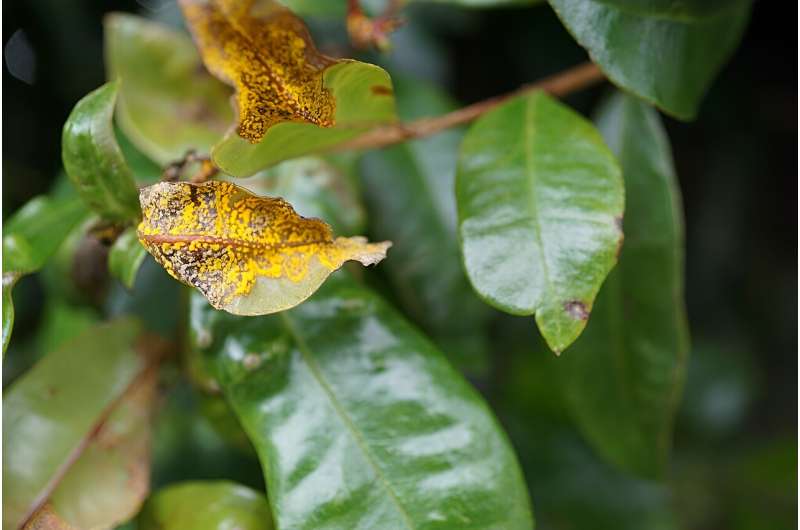This article has been reviewed according to Science X's editorial process and policies. Editors have highlighted the following attributes while ensuring the content's credibility:
fact-checked
proofread
Researchers reveal how myrtle rust pathogen breaks into a host plant

A recent study looking at the molecular foundation of myrtle rust reveals how the pathogen breaks into a host plant and how the host plant responds. This insight will inform the design of useful tools to prevent future break-ins and safeguard plant health.
Dr. Grant Smith has an intense curiosity for Austropuccinia psidii, the fungal pathogen that causes myrtle rust.
"Rusts usually have narrow host ranges," says Grant, a plant pathologist at Plant & Food Research. "This rust is an exception to the rule and attacks a broad range of myrtle hosts."
Grant is determined to learn how this pathogen accomplishes such a feat. Supported by the Beyond Myrtle Rust research program (hosted by Manaaki Whenua-Landcare Research), Grant and a team of collaborators from across New Zealand and Australia have been using a molecular approach to understand how infection occurs. Their findings are published in Phytopathology.
Imagine a pathogen as a bank robber, and its host as the bank. A pathogen's goal is to break in and acquire the resources of its host so it can reproduce and spread. The host's goal is to recognize that it is under attack early and activate its security systems. The respective genetics of the host and the pathogen are what allow each to activate its offensive or defensive responses, a process called gene expression.
"We wanted to know which genes were expressed by the pathogen during infection and which genes were expressed by the plant in response to infection," says Grant.
By looking at the gene expression in the pathogen and in Leptospermum scoparium (mānuka) plants with varying levels of susceptibility at 24 and 48 hours after pathogen exposure, the team learned several interesting things.
From a plant perspective, gene expression in disease-resistant plants didn't change much after pathogen exposure, whereas gene expression in susceptible plants changed dramatically.
"Disease-resistant plants didn't respond because they didn't need to, they are naturally resistant," says Grant. "Susceptible plants turn on lots of genes, but they ultimately lack the ones required to resist infection."
From a pathogen perspective, a narrow suite of genes was expressed in the first 24 hours regardless of whether the pathogen landed on a resistant or a susceptible plant.
"It looks like the pathogen is running a preprogrammed gene expression strategy," says Grant. "It just gets out the dynamite no matter what make or model the bank's safe is."
Gene expression does change 48 hours after infecting the plant as the pathogen starts to acquire the resources of the plant cell so that it can grow and reproduce. But it's that narrow suite of genes expressed at 24 hours that may prove most helpful in fighting myrtle rust.
"We need to catch the pathogen early," says Grant. "These genes become especially important targets for RNA interference or another technology."
Coming back to the bank-robbery metaphor, Grant adds, "If we take away the pathogen's dynamite, it may not be able to break into plant cells at all, halting the infection process in its tracks."
More information: Rebekah A. Frampton et al, Analysis of plant and fungal transcripts from resistant and susceptible phenotypes of Leptospermum scoparium challenged by Austropuccinia psidii, Phytopathology (2024). DOI: 10.1094/PHYTO-04-24-0138-R
Provided by Plant & Food Research




















